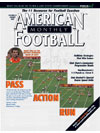AMERICAN FOOTBALL MONTHLY THE #1 RESOURCE FOR FOOTBALL COACHES
Article CategoriesAFM Magazine
|
AFM Subscribers Ask... with Ron Vanderlinden© More from this issuePenn State Linebackers Coach Ron Vanderlinden answered questions from subscribers in the May issue of AFM. Because of the subscriber response, he answers additional questions about the linebacker position. A coach for more than a quarter century, Vanderlinden has coached at Bowling Green, Michigan, Ball State, Colorado, Northwestern, Maryland and Penn State. He was the Terrapins head coach from 1997-2000 and this fall enters his seventh year in Happy Valley. Q. What is the teaching progression you use when teaching linebackers how to drop properly? How do you measure their performance through that progression? Ryan Ruschhaupt, Assistant Coach, Monterey Peninsula University. AFM subscriber since 2004. My first response is to recommend that high school coaches refrain from teaching their players not to ste....The full article can only be seen by subscribers. Subscribe today!
|
|
|||||||
| HOME |
MAGAZINE |
SUBSCRIBE | ONLINE COLUMNISTS | COACHING VIDEOS |
Copyright 2025, AmericanFootballMonthly.com
All Rights Reserved





